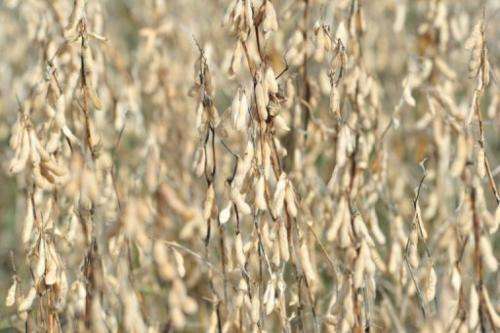Soybeans are seen in this October 27, 2012 photo near Midland, Virginia. While genetically engineered or genetically modified (GM) wheat has not been approved for commercial planting, GM corn and GM soybeans already reign supreme on American farms.
The discovery of unauthorized genetically engineered wheat growing on a farm in the US state of Oregon has cast a spotlight on agricultural biotechnology and the debate about its safety.
While genetically engineered or genetically modified (GM) wheat has not been approved for commercial planting, GM corn and GM soybeans already reign supreme on American farms.
By 2012, 88 percent of corn (maize) and 94 percent of soy grown in the United States were genetically modified, according to the US Department of Agriculture.
And with the US market now well saturated, seed firms are eying China and South America to spur growth and profits.
The main players are US firms Monsanto, DuPont and Dow Chemical, as well as Germany's Bayer and Syngenta of Switzerland.
Since their introduction in the 1990s, GM products have conquered agriculture in the US and hold a large share of the food on Americans' plates.
Though most genetically modified organisms (GMOs) are not directly involved in human consumption, "60-70 percent of processed foods have ingredients derived from GMOs," said Bill Freese of the Center for Food Safety, an anti-GMO organization.
Besides corn and soybeans, GM crops grown in the US include cotton, sugar beets and rapeseed.
In addition, a genetically engineered growth hormone, recombinant bovine growth hormone, is widely injected in cows to boost milk production.
The US government vouches for the safety of GM products. The industry is regulated by the Department of Agriculture, for farm biotechnology, and the Food and Drug Administration, which governs food and food ingredients.
But the developers of the GM products are deeply involved in certifying their safety. The FDA, for instance, depends on a consultative process with developers who voluntarily present their plans to the agency before marketing the products.
Doubts are strong in Europe, where a number of countries, including France, have banned GM crops.
US farmers, though paying more to buy GM seeds, find them worthwhile. Corn and soybeans have been modified to improve resistance to weeds and insects, for example, to help farmers boost productivity.
"If by planting a GMO variety your yield increases faster than it would if you didn't, your future rewards are going to increase," said Bill Nelson, a soybean analyst at Doane Advisory Services.
And the structure of some government crop insurance programs favor that productivity, giving farmers even more incentive to plant GM seeds rather than traditional seeds.
For Freese, a science policy analyst at the Center for Food Safety, GM seeds' very dominance is promoting their use.
"It's become harder and harder for farmers to even find conventional seeds," Freese said.
"The big players bought up conventional seed companies," he said, "and the university public sector breeders which used to produce most of the seeds that farmers used have seen their funding reduced."
Freese noted that cross-pollination of conventional fields by GMO strains has become so widespread it is difficult to produce "pure" seeds that are not contaminated.
Some organic seed developers grow their seeds in South America because they cannot find sources to buy pure seeds in the US, he said.
Yet the seed giants are facing a growing opposition to GM products in the US, with some consumers calling for GM product labeling.
Ben & Jerry's, the activist ice-cream maker, said in April it would stop using GM-sourced ingredients, which make up 20 percent of its products by volume, by the end of the year.
Whole Foods Market, the upscale natural and organic supermarket chain, announced in March that all its products in its US and Canadian stores would be labeled if they contain genetically modified organisms by 2018.
Meanwhile, the outlook for the seed giants remains bright outside the US, especially in rapidly growing South America and China.
With China's expanding middle class and appetite for meat, the Asian powerhouse will need to import huge quantities of soybeans and corn for animal feed, Nelson said.
"That can't happen without the majority being GMO."
© 2013 AFP




















